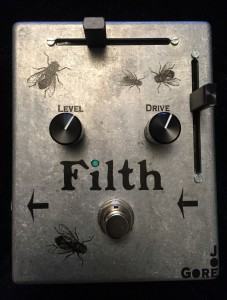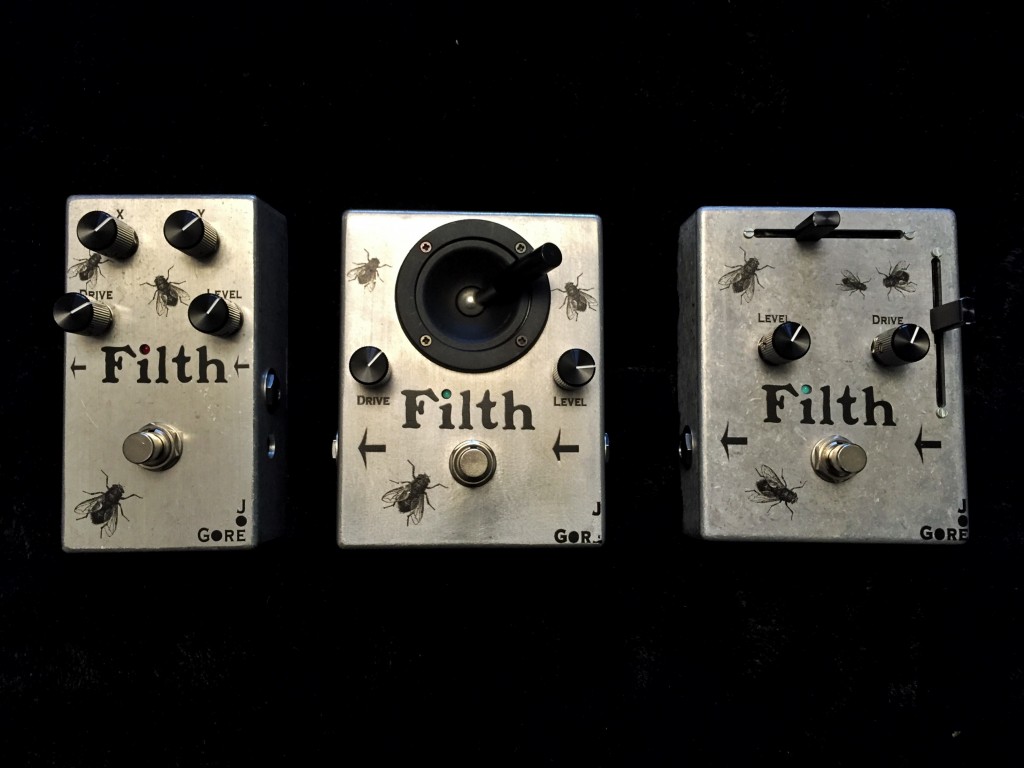
My Filth Fuzz pedal is finally in production and will be shipping within a few weeks. It’s one of three new pedals I’ll be showing at this week’s NAMM show in Anaheim, California. I just finished the demo video, and I’m stoked about how it’s sounding.
I’ll also be debuting three other new pedals: Gross Distortion, Cult Germanium Overdrive, and Boring Boost & Buff. Filth, Gross, Cult, and are finalized and in production, and should be available from my partner, Vintage King, sometime in February. (Vintage King is also currently the sole vendor of my Duh Remedial Fuzz, released last year.) We’re still working out a minor bug in Boring, but it should arrive soon after.
Now, it’s not like I can afford a proper booth or anything, so when I say “I’ll be showing these at NAMM,” I mean I’ll be walking around with a bag of merchandise. I’ll have a pedalboard with all my products on display at the Vintage King booth in Hall A, but sadly, it won’t be set up for demoing — there just isn’t enough space. However, my super-cool friends at Voodoo Labs will have a Filth Fuzz on their demo pedalboard, so you can take it for a spin in their booth while checking out the new stuff from that ever-innovative company. (I have no business connection to Voodoo Labs — they’re just helping me out because they’re nice.)
If you’re going to the show and would like to meet up, contact me and we’ll work something out. 🙂
Here’s what I wrote about Filth on its product page. (If you’re allergic to marketing copy, skip ahead, where I share some interesting backstory on how we arrived at the interface design.)
Man, I love those mad scientist fuzzes with too many knobs! I’ve collected them for decades and used them on a zillion sessions. It got to the point were people were hiring me specifically to make those sort of farting, fried-circuit tones.
But the downside of those complex fuzzes is that they’re a little too wide-ranging, with many settings you’ll probably never use. It’s easy to spend 20 minutes dicking around with the dials without nailing the perfect tone. I’ve always wished for a wild, highly variable fuzz that was a bit more “curated,” with easier access to the tones you’re likeliest to use.
That’s what inspired the Filth Fuzz. It’s only got four controls, but it’s a cornucopia of cool, quirky, and usable fuzz flavors.
The drive and level controls do what you’d expect. But unlike many fuzz drive controls, this one sounds great throughout its range. Extreme settings are molten-lava thick. Lower settings are like…slightly cooled lava, maybe?
But the real action is in the two sliders. They’re tone controls of a sort, but not in the usual way. Most fuzz tone controls are tone-sucking passive circuits situated downstream from the fuzz effect. But here, the sliders alter the voltages at the transistors, radically changing not only the tone, but also the timbre, response, attack, sustain, and compression. In other words, the sliders radically alter the fuzz’s core character, as opposed to simply EQing a single core tone.
TO USE: Set desired gain and output levels. Move the sliders till it sounds awesome.
CAUTIONS: Filth sounds best before any buffered effects. It usually works best at or near the front of your effect chain.
Filth Fuzz was created in San Francisco and is built in Michigan by skilled craftspeople earning a fair wage.
Filth’s sound hasn’t changed since I concocted the circuit on breadboard a few years ago. but the interface has gone through many iterations. It kept changing even after I sent schematics and prototypes to Tony Lott at Cusack Music (my manufacturer). Here’s a pic of three production prototypes:

Three incarnations of Filth Fuzz (in order of appearance).
To dial in tones on Filth, you adjust two highly interactive pots (let’s call them x and y), which tweak the voltages going in and out of the transistors, providing many tone variations. The original version used two standard pots for these x/y controls. It worked okay, but the ergonomics weren’t ideal. I’ve found that the fastest way to refine sounds is to move both pots at once over a sustained note or chord, and it was just a bit awkward having to take both hands off the guitar to turn the controls simultaneously.
So I decided to employ a joystick, which lets you adjust x and y with one hand (and it looks pretty bitchin’). The ergonomics were great, and I thought we’d finalized the format.
But then I showed a joystick prototype at the L.A. Amp Show in October, and for the first time I had a chance to sit back and watch other guitarists interact with the device. Players seemed to have a blast with it, but I kept noticing how often a heavy stompbox foot would land perilously close to the joystick’s none-too-sturdy shaft.
Meanwhile, we discovered that the the only compatible joystick option cost about $25 per unit — enough to jack the retail cost way up. Also, it was tricky to replicate exact setting via the joystick, which would suck if, say, you were trying to get identical tones night after night on tour. (I knew that when I first opted for the joystick, but I’d figured the fun factor would more than compensate.)
Then Miko Mader, a clever guitarist who works for my distributor, M1, came up with the perfect solution: Why not use two sliders instead of pots? Tony at Cusack sourced the perfect part, and we prototyped a third version.
Bingo!The ergonomics were great (check out the demo video to see how quickly you can change sounds with one hand). You can mark exact settings with tape if you need to, easily repeating specific sounds. The two sliders are a fraction of the cost of a single joystick, so we can sell the pedal for far less. (We’re still nailing down the retail price as I write.) There’s no fragile shaft to break. And while I miss the goofy fun of the joystick, the sliders are still pretty darn entertaining. (So thanks, Miko, for your brilliant idea.)
I’m really stoked about this pedal. I hope you enjoy it as well.








seriously, no comments yet? It sounds great Joe! I love how tight and balanced it is. Typical use aside, I could envision that being a great unit to have between the guitar and a recording preamp for itb processing – a bit of grit, a bit of compression, and a lot of thick tone. Nicely done!
Which reminds me, your old two knob bulk fuzz is almost permanently on in my minimal pedalboard – knobs about 60% – just enough to add a little excitement to the signal. Every couple weeks I notice that it’s on, then turn it off for a few minutes, feel like I’m missing something, then turn it back on and forget about it for another couple weeks.
Maybe people are shy. Or they hate it. 🙂
I can’t take any credit for the Bulk — it’s just a popular DIY circuit (though I did steal one little trick from it for my Duh fuzz.) I agree — it’s a great-sounding circuit, maybe BECAUSE it’s so minimal.
That pedal sounds great. And the playing is amazing as usual. Good luck at NAMM!
Thanks, Hernan — I really appreciate your kind words and good wishes. 🙂
Joe, great pedal. Sounds great. Also like the very businesslike sliders, so you can tweak with the tip of your sneakers and dial in some tone without breaking a batswitch or something. Nice.
like the sound, like the control schema. watching for this one to come out.
I really like your pragmatic approach to pedals. They are great sounding and boldly go where no pedals have gone before, in that you aren’t limited to chasing the vintage mimicry that plagues so many other builders. They seem to have improvements made in such logical ways that arise from a real users perspective and experience, not someone trying to copy imperfect old ones.
Thanks for the lofty compliments, Skot! I don’t have a problem with vintage mimicry per se — I built plenty of by-the-book clones when I was learning, and I like being able to get good copies of classic gear at sane prices. But the stompbox field is so very crowded, I figured the only way I could contribute was to make stuff that’s a bit different. 🙂
Joe! This is awesome man, I just stumbled on your page and am really digging your pedals. Definitely the filth!
Love the design with the sliders, would be solid for a quick change on the go live or when you are jamming out, definitely a nice design touch.
I recently did a review of some of the more main stream fuzz pedals, nothing special but just my thoughts on some of the ones out there. I am going to be doing a review on some boutique pedals soon and will hopefully be able to include this on there! Just wanted to say keep up the great work and really great design on the filth!
Hi Connor! Wow — I’m so glad you dig it. I’m not sure if you read the notes, but the previous version used a joystick instead of two sliders. That model is fun as hell, but a) the joystick part was ridiculously expensive, b) it was too fragile, and c) it made it difficult to mark see specific settings. The two sliders are less over-the-top, but in the end, they’re just more pragmatic. 🙂
dude…first you are a friggin cool guitar player…but man…this new fuzz interests me alot
Hey, Rick! Glad you’re entertained. 🙂
$269 MSRP at Vintage King?
Does one get a Starbuck’s coupon or some other form of trendy swag for laying down this kinda dosh ? I know COLA is high in the Bay Area but c’mon, $269! Really???
….especially given the simple-circuit/DIY quip
Pretty far reach IMO and I’ll be passing on this one.
Sorry to hear that. It’s actually a pretty typical price for a US-made small-production pedal with a couple of expensive mechanical parts. True, it would be substantially less expensive were it made in China.
Fair trade + fair wages + small business + local ingenuity + higher costs = higher MSRP. Worth every penny. Worth saving up for.
[…] in its line in the Janus. A prototype of former Premier Guitar editor Joe Gore’s excellent Filth Fuzz used a joystick before he recognized the perils of fuzz-crazed users stomping it to death. […]